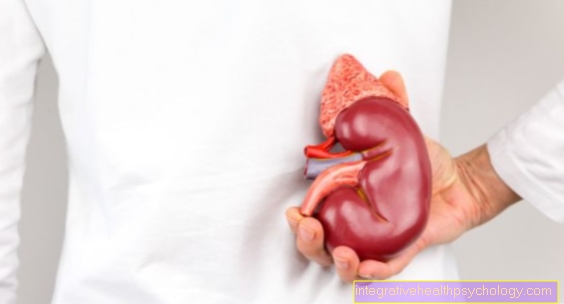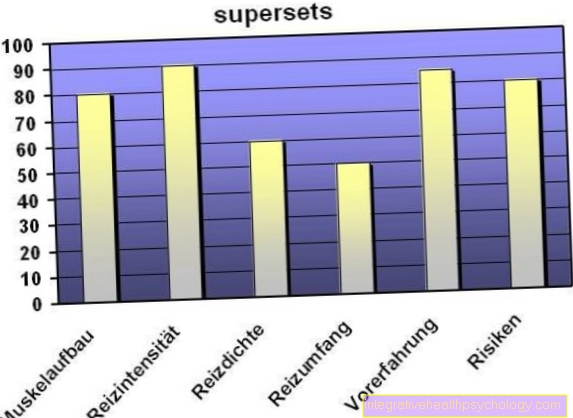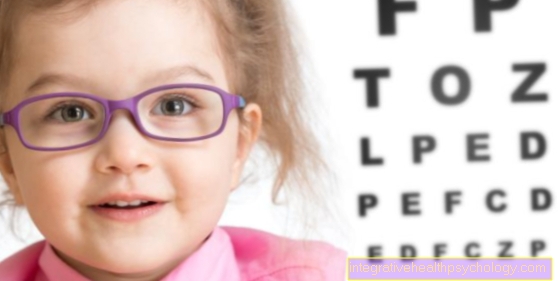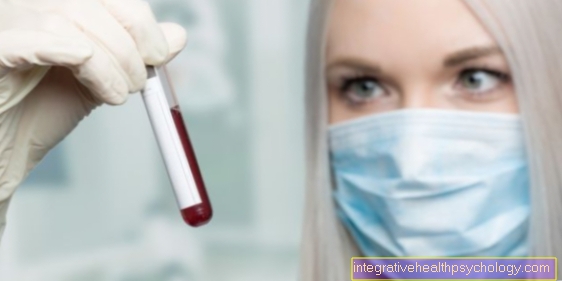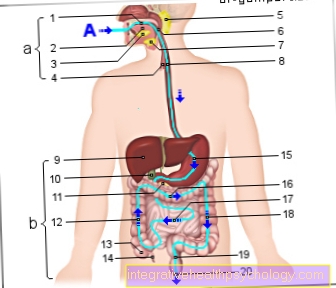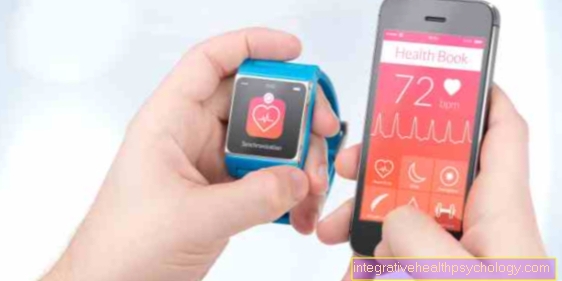Glandular fever in babies
introduction
Pfeiffer's glandular fever, also known as Epstein-Barr virus infection, infectious mononucleosis or "kissing disease", is caused by an infection with the so-called Epstein-Barr virus. It is a virus from the herpes virus family. In our part of the world, the vast majority of the population, i.e. over 95%, is infected with the Epstein-Barr virus by the age of 30.
Most of the time, however, children get sick at a young age. The infection takes place via the saliva, for example when kissing, which gives the disease its name "kissing disease". An infection with EBV in infancy is very often without symptoms, especially with Pfeiffer's glandular fever in babies, the symptoms of the disease are rather unspecific. Infections in adolescence or adulthood, however, often show the typical symptoms of Pfeiffer's glandular fever. This results in a feverish sore throat and tonsillitis with characteristic coatings, swelling of the lymph nodes all over the body and a typical change in the blood count. Therapy is purely symptomatic by lowering the fever and relieving pain. In immunocompromised patients, mononucleosis usually heals without consequences.

Symptoms
The full picture of infectious mononucleosis consists of a mostly generalized lymph node swelling, whereby the lymph nodes appear as flexible and not very painful, a feverish tonsillitis with gray coatings and a characteristic change in the blood count with a sharp increase in leukocytes (the white blood cells), which have a high proportion of so-called mononuclear cells.
However, this classic symptom constellation cannot always be observed. Pfeiffer's glandular fever is often difficult to diagnose, especially in babies, as the symptoms that occur are very unspecific and could also speak for many other infectious diseases. The classic symptoms are often accompanied by fever, headache and body aches, fatigue and a severe feeling of illness. Roughly three different course forms can be distinguished. Depending on the main infestation pattern, these forms of progress are divided into:
- Swelling of the lymph nodes (glandular shape)
- Rash (exanthematous form)
- Inflammation of the liver (hepatic form)
You can find more on the subject under: You can recognize Pfeiffer's glandular fever by these symptoms
1. Swelling of the lymph nodes
In the case of the glandular form, which is more or less the characteristic form and is by far the most common, one often observes one that occurs all over the body Swelling of the lymph nodes. These lymph nodes are mobile and not very painful. Typical places where you can feel this lymph node swelling are Neck area, the strip or under the Armpits. In addition, the spleen can swell very strongly with this form of the disease, which in extreme cases can even lead to the organ being torn. In addition to lymph node swelling and Spleen swelling can be the above described Tonsillitis watch with gray deposits.
2. rash
In addition to the typical characteristics and complaints of Pfeiffer's glandular fever, it comes about 3% of the cases also to one Developing a rash.
Typically the Rash on the 4th to 6th day after the onset of the disease. This rash (a rash is also known as an exanthem) is usually fine-spotted and nodular-fine-spotted.
In addition to the morbilliform rashes (reminiscent of measles), there are also rubeoliform variants, which are correspondingly reminiscent of rubella. As a non-specific reaction of the body can red wheals (Urticaria) occur.
The typical localization is the Body trunk leaving out the extremities and face. However, the rash can also generalize and appear all over the body. In addition, a severe itching occur. In some cases, the rash affects the Mucous membrane on the hard palate. One speaks here of a petechial enanthem, the like smallest hemorrhages impressed.
At the lateral edge of the tongue are also found often white, non-removable coatings. Doctors speak of oral hairy leukoplakia.
If in Pfeiffer's glandular fever the liver is affected and the Bile pigment bilirubin is no longer absorbed, it passes into other tissues and causes one in those affected Yellowing of the skin (jaundice).
In newborns with a yellowing of the skin, the demarcation is to one Neonatal icterus important. Since Pfeiffer's glandular fever is not a typical disease in babies in terms of age distribution, a yellow color should be used Pediatrician for further clarification be consulted.
You can find more information on the topic here: Rash on baby
3. Inflammation of the liver
Another, rather rare form of disease also affects the liver. This causes inflammation of the liver, which is also known as hepatitis.
So is the transmission route
Pfeiffer's glandular fever, or infectious mononucleosis, is a disease that is transmitted by the highly contagious human herpes virus-4. The virus is found in the patient's saliva and is still highly infectious for a long time after the illness. In the vernacular, Pfeiffer's glandular fever is also called “kissing disease”, as it is most commonly transmitted after contact with infectious saliva. So the virus can simply be spread through a kiss. Or when the baby's pacifier or cutlery is used by a sick person.
Gradient forms
The course of mononucleosis also varies with age. The population group most frequently affected by glandular fever is adolescents. The typical symptoms are most pronounced and characteristic in this age group. The younger the children are, the easier and more harmless an EBV infection is. Babies and small children often only suffer from fever, fatigue and swelling of the lymph nodes. For this reason, diagnosis is much more difficult than in adolescents. In babies and young children, the symptoms may even be completely absent, so that although they are infected with the Epstein-Barr virus, they do not develop any symptoms of the disease.
If a mother came into contact with the Epstein-Barr virus before pregnancy and then formed antibodies, she will pass these on to her baby for the first few months of life. This prevents the newborn babies from contracting Pfeiffer's glandular fever in the first few months.
More information on the topic Course of Pfeiffer's glandular fever you'll find here.
In the very rare exanthematic form, a rash can be found on the hard palate.It is imperative to mention here that some antibiotics such as amoxicillin very often lead to a rash and should therefore not be administered under any circumstances.
diagnosis
The diagnosis can be made on the basis of the typical clinic in conjunction with the associated laboratory findings. When infected with glandular fever, there is a typical increase in white blood cells, which is known in medicine as leukocytosis. With a proportion of 50-80%, so-called mononuclear cells, a subgroup of white blood cells, can be found among the white blood cells. In addition, antibodies can be detected in the blood in order to diagnose an illness with Pfeiffer's glandular fever. Such an antibody test can not only diagnose Pfeiffer's glandular fever itself, but also distinguish whether the infection is fresh or not. Especially the blood results and the detection of antibodies lead to the diagnosis of Pfeiffer's glandular fever in babies, since the typical symptoms may be missing here.
Read more about this under: Neonatal Infection and Diagnosis of Pfeiffer's Glandular Fever
Risk of infection with glandular fever
Not only the symptoms are age-dependent, but also the incubation period, i.e. the time between infection with the Epstein-Barr virus and the outbreak of Pfeiffer's glandular fever. While the incubation time is around 50 days in adolescents and adults, this time is significantly shorter in babies and children with around ten to 14 days.
Read more about the topic here: Incubation period of Pfeiffer's glandular fever
Once infected, otherwise healthy and immunocompetent people have lifelong immunity to the disease. After an initial infection, the virus colonizes the nose and throat and can be reactivated and excreted from time to time. During this period there is a risk of contagion for fellow human beings. Typically adolescents and young adults are affected by the disease, which is spread through saliva. This is how the name "kissing disease" is derived, since the virus spreads through the exchange of saliva in the age group of young people and adults. Babies and toddlers, on the other hand, usually get infected from their parents when they kiss their offspring. So if you want to prevent the virus from spreading, you should avoid any saliva contact with a sick person. The rule here is that not only kissing is prohibited, but also the use of forks or glasses of the infected person. It is estimated that the majority of the population in western countries, over 95%, are infected with the Epstein-Barr virus.
You can find much more information on this subject at: Pfeiffer's glandular fever is so contagious!
Duration
As a rule, Pfeiffer's glandular fever disease lasts about three to four weeks. However, it often takes months for the patient to regain his or her previous performance.
Since the infection is usually more harmless in babies and toddlers, they usually recover from it more quickly.
You can find out more about the duration on our website Duration of Pfeiffer's glandular fever
Therapy, prognosis and prophylaxis
Pfeiffer's glandular fever is a viral infection with the Epstein-Barr virus. As with many other viral infections, Pfeiffer's glandular fever can only be treated symptomatically. Among other things, fever and pain occur in the course of Pfeiffer's glandular fever. As part of symptomatic therapy, fever can be lowered and pain can be alleviated. In childhood and adulthood, this can be done either with paracetamol or ibuprofen, both of which have an antipyretic and analgesic effect. For babies and toddlers, however, it should be noted that these medications must not be dosed as they are for adults. This is because their liver function is not as well developed as in adults. In case of doubt, the dosage should be discussed with a pediatrician.
The patient remains a carrier of the Epstein-Barr virus for life, so that Pfeiffer's glandular fever can flare up again. In immunocompromised patients, the prognosis is good and the disease heals without consequences. So far no vaccination against Pfeiffer's glandular fever is possible. The only possibility of prophylaxis is to avoid the sick person. Since the Epstein-Barr virus is transmitted via droplet infection with the saliva, kissing or sharing dishes should also be avoided. This means that adults who suffer from an infection, possibly caused by reactivation, should avoid bringing babies and young children into contact with their saliva.
Read more on this topic at: What to do if your baby has a fever
Administration of antibiotics
Under all circumstances, one should antibiotic therapy avoid. Since tonsillitis in Pfeiffer's glandular fever can easily be confused with tonsillitis caused by bacteria, it regularly occurs incorrectly Prescription of aminopenicillins such as. Ampicillin or amoxicillin. This type of antibiotic is then used in almost all cases skin rash provoked all over the body who after about two weeks disappears again. In addition, there is usually also itching. However, this reaction is not an allergic reaction.
In approx 10% of the cases it actually comes to one Superinfection with bacteria in Pfeiffer's glandular fever. Then preventive other antibiotics given to another class without hesitation. These will not cause a rash.
How dangerous can glandular fever be?
In most cases of glandular fever in babies, the course is mild or asymptomatic. At the beginning of life, the child is helped by maternal antibodies that are still in the blood. In severe clinical courses, however, some dangerous complications can arise. It is important that the child takes physical rest in the event of a severe infection. The spleen can swell and in the worst case rupture. Kidney failure, meningoencephalitis or inflammation of the heart can also occur. To prevent this, if the baby is in poor general condition, it should be clinically monitored, bed rest, given enough fluids and not take antibiotics.









